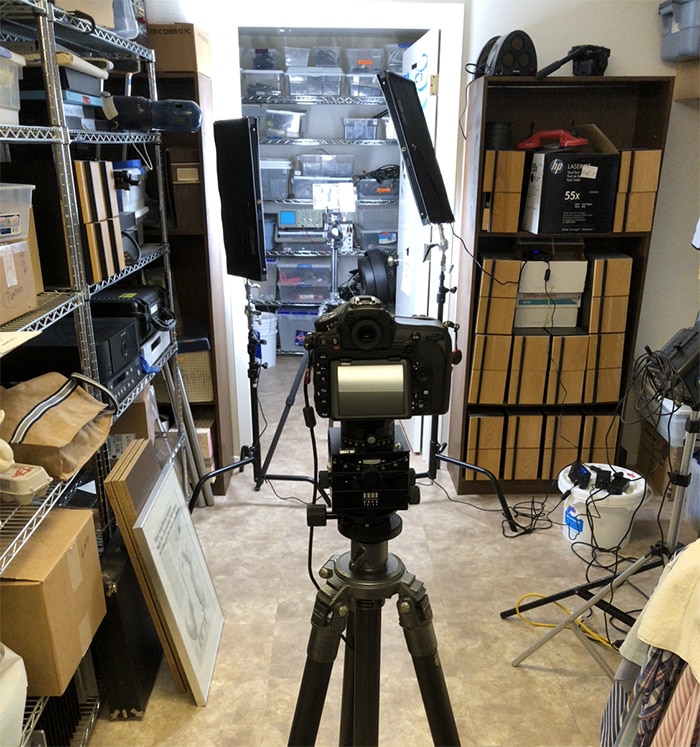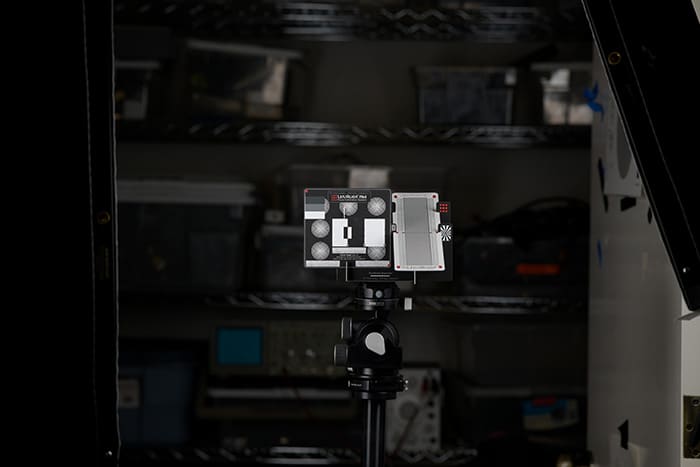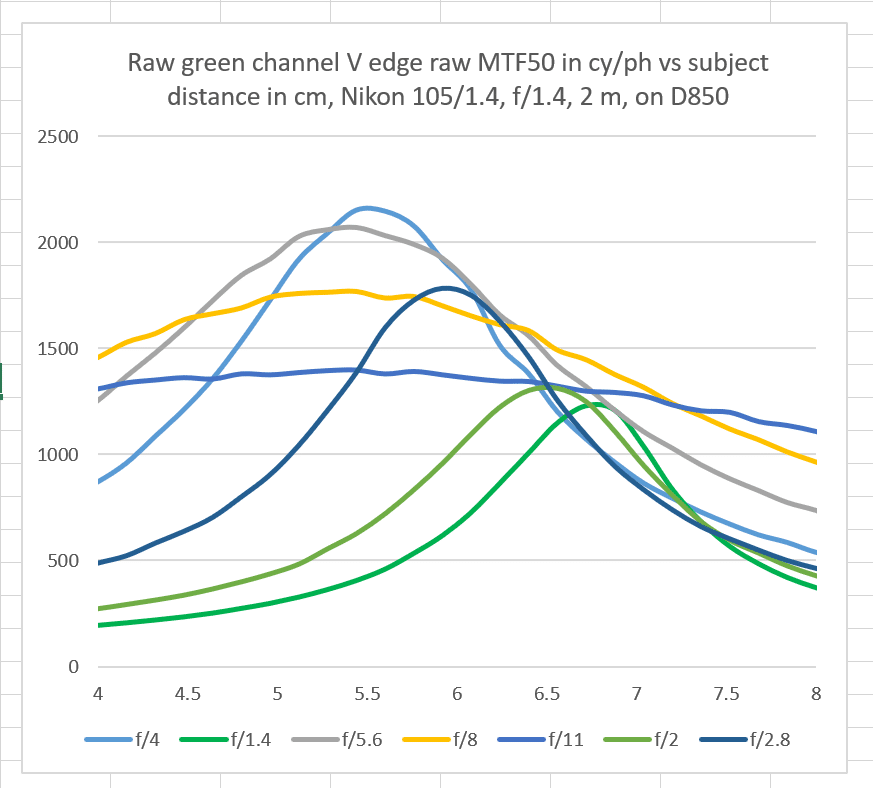This is a continuation of a series of posts on the Nikon D850. The series starts here. You should be able to find all the posts about that camera in the Category List on the right sidebar, below the Articles widget. There’s a drop-down menu there that you can use to get to all the posts in this series; just look for “D850”.
I’m setting aside the a7RIII for a moment while I look at how to tune the phase-detection autofocus (PDAF) system on the D850. I picked a lens that we’ve seen a lot in this series of tests, the Nikon 105 mm f/1.4. In the past, I’ve tried to tune the PD autofocus system using the built-in feature of the D850. As with the D5, I found the experience frustrating because of the large variability of the PDAF system in the camera when used with a fast lens.
So I bought a copy of FocusTune from Michael Tapes. While I was at it, I got the latest version of the LensAlign target. I’ve been a user of ZigAlign and LensAlign since I was aligning enlargers and calibrating rangefinder cams, but it had been a while since I got something to use that’s newer than my old LensAlign Pro. The new (v4) LensAlign is nowhere near as solidly constructed as the now-defunct Pro was. In fact, it feels kinda Mickey-Mouse while you’re assembling it. But it all goes together, and it looks like it should do the job. The “ramp” part is completely different, the better to work with FocusTune, I suppose.
Here’s how I set it up:
I used a couple of Wescott LED panels with thin diffusers to light it.
FocusTune itself feels like a program from another era, with a command-line window that opens when you fire it up and a GUI that reminds me of Win XP. But it does the job. The training materials on Michael’s site seem to be aimed at people who already watched the video tutorial. I hate videos, so I was at somewhat of a disadvantage, but I figured things out pretty quickly. My only screwup had nothing to do with the program itself; I persistently forgot to take the camera out of live view during the captures, and FocusTune made me go through the exercise of identifying the ROI corners before it gave me a generic “Not enough qualifying files…” message. I sent the EXIF data to Michael, and he pointed out my bonehead mistake (without calling it that). Then I was on my way.
Here’s what a shot looked like from the camera’s point of view:
Here’s the result of testing the 105/1.4 wide open with 10 shots at each AF-compensation setting:
This is a very nice presentation since it shows you the sample variation, and even gives you a graphic that’s indicative of the standard deviation (known around this blog as sigma). Look’s like +6 is the right setting at this distance, which was about 10 feet.
But from previous tests, we know that the 105/1.4 has quite a lot of focus shift. Let me refresh your memory:
You can see that if you focus at the best sharpness wide open, you get about 800 cycles per picture height (cy/ph) at f/4, instead of the 2200 cy/ph that the lens is capable of at that stop.
The word on the street is that Nikon compensates for focus shift when you use Nikon lenses.
Does it really?
I reran the FocusTune testing with the same setup, except I stopped the lens down to f/5.6:
Now FocusTune says that we need -4 or -5 for our AF tweaking instead of the +6 that was the right correction at f/1.4. Note the lower sigmas because of improved DOF.
What to do? Leave the correction at zero and split the difference? Change the correction with f-stop?
I dunno, but what I do know is that I’m going to be so forking glad to see the end of PDAF without CDAF tweaking. The a7RII (and now the III) have spoiled me. I will say that I think that FocusTune is a far better way to tune the D850’s PDAF than the built-in tool. And trying to use LensAlign without FocusTune for PDAF calibration? Life’s too short.





deejjjaaaa says
> The word on the street is that Nikon compensates for focus shift when you use Nikon lenses.
wasn’t that word from a reputable person like MOElund ?
JimK says
Yes, I think so, but I can’t find the link now, and don’t want to put words in her mouth unless I’m sure that’s what she said. Do you have a link?
Edna says
Did I miss an article that would validate this statement ?
” I will say that I think that FocusTune is a far better way to tune the D850’s PDAF than the built-in tool.”
I never saw a review or comparison of the 850’s built in tool.
JimK says
I guess I was too dejected after trying to use it that I never wrote it up. The problem is that there’s so much variation in the PDAF for wide apertures in the first place (and, to a lesser extent, in your comparison capture), so you’ve got to do test captures over and over, and the Nikon tool gives you no help with the statistics.
Edna says
I used Steve Perry’s recommendations and it did improve my prime AF lenses on the 850
https://www.youtube.com/watch?v=5cHhrWF-pqM
JimK says
I’ve seen this before, and I think it is a good way to use the autotuning feature. But there’s a lot of fiddling around and writing things down and there’s the uncertainty in the reference focusing. The FocusTune approach takes less time for me, does the stats, and plots the results automatically. You can see right away if you’ve got any outliers. So, net: easier, faster, more accurate (I think) and less error-prone.
deejjjaaaa says
“although some Nikon camera bodies made since 2014 do have the ability to compensate for focus shift by applying a predictive algorithm.” (c) Her
JimK says
Thanks. Here’s the link:
https://www.dpreview.com/forums/post/60260772
deejjjaaaa says
so what is your take about compensation upon consideration… “fake news” ?
JimK says
Too early to tell. I would hesitate a long time before contradicting Marianne. She is very technically competent, accurate, and inventive. In addition, she has a different philosophy about publication than I. I put my findings out there while they’re fresh, and refine them with the help of netizens. Marianne gets everything checked and double checked, then she publishes.
Edna says
Is she correct ?
Geoff says
So -6 AF FT at f/1.4 and -4 AF FT at f/5.6. Does this make this lens unusable? Do we have to set the AF FT at different numbers for every shoot depending on the aperture preference? Or is it OK to just leave at 0 and hope that the very slight misfortune is not noticeable?
I guess the question for you Jim is: are these small errors noticeable in the final images or not?
Geoff says
+6 of course at f/1.4